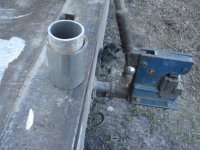TomPenny
Bronze Member
[I have to let the concrete stiffen up enough to hold the post for height and line]
Thats what I've been waiting to hear. I knew you notched your posts and then set them for line and height. I just didn't know how you managed to keep them from dropping. You must let them set quite a bit.
There's a lot of pipe fence around here. When I did my fence
Link I looked around at a bunch of others first. More often that not the top rail would roller coaster to the extent that it appeared there was not preparation or planning at all by the installer. Some post height would look like he measured off a dirt clod.
So I was bound and determinded not to have a top rail that looked bad. I set the posts and then cut them using one of the clamp on templeates and soap stone. I took my time using string and a lot of eye balling. I would try to look down the line to anticipate how to gradually follow the slight grade.
Also before I even dug a hole I worked the line with a grader blade.
In the end I have one of the better looking fences around in terms of the top rail. Me and three neighbors on each side all have the same fence. Unfortuntly theirs are real bad.
That being said it took me forever to do. I think I'd rather notch the posts first. Guess I need to practice.
Thats what I've been waiting to hear. I knew you notched your posts and then set them for line and height. I just didn't know how you managed to keep them from dropping. You must let them set quite a bit.
There's a lot of pipe fence around here. When I did my fence
Link I looked around at a bunch of others first. More often that not the top rail would roller coaster to the extent that it appeared there was not preparation or planning at all by the installer. Some post height would look like he measured off a dirt clod.
So I was bound and determinded not to have a top rail that looked bad. I set the posts and then cut them using one of the clamp on templeates and soap stone. I took my time using string and a lot of eye balling. I would try to look down the line to anticipate how to gradually follow the slight grade.
Also before I even dug a hole I worked the line with a grader blade.
In the end I have one of the better looking fences around in terms of the top rail. Me and three neighbors on each side all have the same fence. Unfortuntly theirs are real bad.
That being said it took me forever to do. I think I'd rather notch the posts first. Guess I need to practice.

